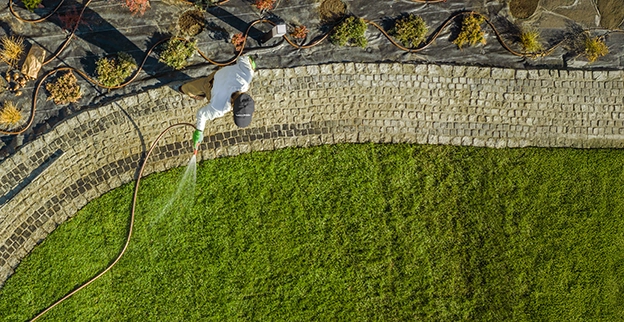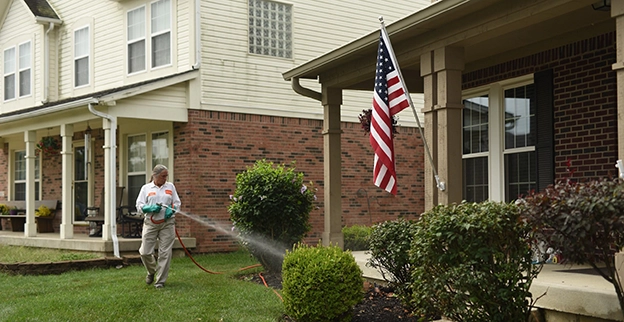Your lawn needs water to thrive and survive. However, too little or too much water can harm your grass. So, how do you find the right balance? The experts at Lawn Pride are here to help you.
Lawn Watering Tips for Central Indiana
Know how much to Water your Lawn in Indianapolis

.webp)
How to Water
There are many different methods to water a lawn. If you are a homeowner with the convenience of an in-ground irrigation system; watering is as easy as making sure you’re programming your system correctly. However, not all homeowners have that luxury. Here are some helpful tips to make this process a little easier and more efficient.
Sprinkler Type
Use a pulsating sprinkler instead of an osculating sprinkler. Pulsating sprinklers help prevent evaporation, and they put water where it’s supposed to go. Oscillating sprinklers are also more susceptible to wind and can make it harder to get all areas of your yard without moving it constantly.
Sprinkler Placement
Taking a little time to draw out a plan can save lots of time in the long run. This will help you map out the most efficient way to water your entire lawn. If you only have one sprinkler; you can set it up, let it run for thirty to forty-five minutes, then move it to the next location. If possible, try positioning multiple sprinklers inside landscaped areas. This way you can keep sprinklers and hose set up throughout the season and watering your lawn is as easy as turning on the water. Just remember to put hoses away before winter. If you can’t avoid placing a sprinkler on your lawn; make sure not to leave the hose lying in the lawn for long periods (this can kill the grass underneath).
Watering Tools
Today, there are many tools available to help make watering your lawn easier, more efficient, and more convenient. Let's face it, no one wants to spend the time (or has the patience) to stand outside watering their lawn with a hose. Even having to move a sprinkler around the yard to make sure the entire lawn is getting watered correctly can be tedious. Below are a couple of inexpensive tools you can try.
Timers
Hose timers can be a lifesaver and take your lawn maintenance to the next level. There are many different types of hose timers on the market. Some control a single hose, while others can control up to five different hoses. Some even have a rain sensor that will stop your sprinklers from running if it is raining. Which one you choose will depend on what your particular needs are and how much you are willing to spend.
Moisture Sensors
A well-watered lawn will be moist down to about six inches in the ground. If you don’t want to dig holes to measure, use a soil moisture sensor. These gadgets kind of look like a meat thermometer, and come in manual and digital models. Simply stick the metal probe into the soil and it will tell you if your yard is wet enough.

Additional Watering Tips
If you want to keep your lawn healthy, you will need to change your watering habits as weather conditions change. Below are some tips on how to adjust your watering habits during common Central Indiana weather conditions.
Watering Edges
Does the edge of the lawn look dead? Cement, brick, and other types of landscape edging can hold heat causing the grass to brown out along the edges. Increase the watering time in these areas by 15 minutes to help prevent heat damage along the edges of your lawn.
Watering During Hot Dry Weather
Watering your lawn can be costly especially during long periods of hot dry weather. Try to water your lawn at least twice a week for thirty to forty-five minutes. Your lawn may still look dry. This is because the lawn will try to protect itself by going dormant when it doesn’t get the amount of water and nutrients it needs. Watering this small amount every week will help to sustain the root system until the weather turns around. However, this method is much cheaper than having to rebuild your lawn.
Standing Water
If your lawn holds water because of low areas, you can alleviate this by bringing in soil to level out the lawn
If your lawn doesn’t have low areas but is still hold water; a good core aeration will improve drainage, alleviate soil compaction, and break up excess thatch that can prevent water and nutrients from being absorbed properly.
Is the ground not absorbing water? There are a few conditions that can cause this issue
-
Soil- Many Central Indian lawns have clay-based soil. Clay-based soil is dense causing poor drainage and will harden during Indiana’s hot summers.
-
Low Areas- Lawns that sit low or have large dips or low lying areas can cause water to settle in these areas during heavy or long periods of rain.
-
Weather- Heavy rains can cause standing water on your lawn. This can happen when rain falls faster than the soil can absorb it or when there are long rainy periods.
Contact the experts at Lawn Pride.
Feeding your grass and soil with the right nutrients at the right time will lead to cost-efficient, timely results. Do you want more tips for your Central Indiana lawn? Click here to get a free quote on our Lawn Care Service. Or talk to the experts at Lawn Pride and grow the best yard on the block this summer!
Our Special Offers
We understand your goal to keep your lawn looking its best. We take pride in your lawn because we know you do, too. Check out our special offers to see how you can save on your next lawn care application.
